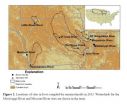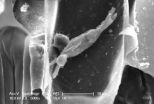(Press-News.org) Invertebrate numbers have decreased by 45% on average over a 35 year period in which the human population doubled, reports a study on the impact of humans on declining animal numbers. This decline matters because of the enormous benefits invertebrates such as insects, spiders, crustaceans, slugs and worms bring to our day-to-day lives, including pollination and pest control for crops, decomposition for nutrient cycling, water filtration and human health.
The study, published in Science and led by UCL, Stanford and UCSB, focused on the demise of invertebrates in particular, as large vertebrates have been extensively studied. They found similar widespread changes in both, with an on-going decline in invertebrates surprising scientists, as they had previously been viewed as nature's survivors.
The decrease in invertebrate numbers is due to two main factors – habitat loss and climate disruption on a global scale. In the UK alone, scientists noted the areas inhabited by common insects such as beetles, butterflies, bees and wasps saw a 30-60% decline over the last 40 years.
The diminishing status of invertebrate populations greatly compromise nature's ability to provide us with what we need. In economic terms, they provide us with important services, often worth billions of GBP£:
Pollination – insect pollination is required for 75% of all the world's food crops and is estimated to be worth ~10% of the economic value of the world's entire food supply. Globally, pollinators appear to be strongly declining in both abundance and diversity.
Pest control – in the US alone, the value of pest control by native predators is estimated at $4.5 billion annually, these costs could escalate with the decline in predator number.
Nutrient cycling and decomposition – insects and vertebrates (birds, for example) are important for cycling nutrients and moving them over long distances, without which the integrity of other ecosystem functions such as plant productivity could be compromised.
Water quality – declines in amphibian populations has led to increased algae and the biomass of waste matter, which in turn reduces nitrogen uptake.
Human Health – decreasing invertebrate numbers are known to compromise food production due to reduced pollination, seed dispersal and insect predation but the impact the continuing loss of animals, including invertebrates, has on the spread of human disease needs to be better understood as a priority.
Scientists believe there is a growing understanding of how ecosystems are changing but to tackle these issues, better predictions of the impact of changes are needed together with effective policies to reverse the losses currently seen. Using this approach, conservation of species can be prioritised with the benefit of protecting processes that serve human needs, and successful campaigns scaled-up to effect a positive change globally.
Dr Ben Collen (UCL Biosciences), last author of the study, said: "We were shocked to find similar losses in invertebrates as with larger animals, as we previously thought invertebrates to be more resilient. While we don't fully understand what the long-term impact of these declining numbers will be, currently we are in the potentially dangerous position of losing integral parts of ecosystems without knowing what roles they play within it.
"Prevention of further declines will require us to better understand what species are winning and losing in the fight for survival and from studying the winners, apply what we learn to improve conservation projects. We also need to develop predictive tools for modelling the impact of changes to the ecosystem so we can prioritise conservation efforts, working with governments globally to create supportive policy to reverse the worrying trends we are seeing."
Professor Rodolfo Dirzo (Stanford Woods Institute for the Environment), lead author of the study, said: "Where human density is high, you get high rates of defaunation, high incidence of rodents, and thus high levels of pathogens, which increases the risks of disease transmission. Who would have thought that just defaunation would have all these dramatic consequences, but it can be a vicious circle.
"We tend to think about extinction as loss of a species from the face of Earth, and that's very important, but there's a loss of critical ecosystem functioning in which animals play a central role that we need to pay attention to as well. Ironically, we have long considered that defaunation is a cryptic phenomenon, but I think we will end up with a situation that is noncryptic because of the increasingly obvious consequences to the planet and to human well-being."
INFORMATION:
Invertebrate numbers nearly halve as human population doubles
2014-07-25
ELSE PRESS RELEASES FROM THIS DATE:
Farmers market vouchers may boost produce consumption in low-income families
2014-07-25
Vouchers to buy fresh fruits and vegetables at farmers markets increase the amount of produce in the diets of some families on food assistance, according to research led by NYU's Steinhardt School of Culture, Education, and Human Development.
The study, which appears online in Food Policy, suggests that farmers market vouchers can be useful tools in improving access to healthy food. This finding validates a new program created by the Agricultural Act of 2014, or farm bill, that incentivizes low-income families to buy produce at farmers markets.
"In terms of healthy ...
Researchers discover new way to determine cancer risk of chemicals
2014-07-25
BOSTON -- A new study has shown that it is possible to predict long-term cancer risk from a chemical exposure by measuring the short-term effects of that same exposure. The findings, which currently appear in the journal PLOS ONE, will make it possible to develop simpler and cheaper tests to screen chemicals for their potential cancer causing risk.
Despite an overall decrease in incidence of and mortality from cancer, about 40 percent of Americans will be diagnosed with the disease in their lifetime, and around 20 percent will die of it. Currently fewer than two percent ...
Less than 1 percent of UK public research funding spent on antibiotic research in past 5 years
2014-07-25
Less than 1% of research funding awarded by public and charitable bodies to UK researchers in 2008 was awarded for research on antibiotics, according to new research published in The Lancet Infectious Diseases.
The study, which is the first detailed assessment of public and charitable funding to UK researchers focusing on bacteriology and antibiotic research, suggests that present levels of funding for antibiotic research in the UK are inadequate, and will need to be urgently increased if the growing crisis of antibiotic resistance is to be tackled effectively by UK ...
Synchronization of North Atlantic, North Pacific preceded abrupt warming, end of ice age
2014-07-25
CORVALLIS, Ore. -- Scientists have long been concerned that global warming may push Earth's climate system across a "tipping point," where rapid melting of ice and further warming may become irreversible -- a hotly debated scenario with an unclear picture of what this point of no return may look like.
A newly published study by researchers at Oregon State University probed the geologic past to understand mechanisms of abrupt climate change. The study pinpoints the emergence of synchronized climate variability in the North Pacific Ocean and the North Atlantic Ocean a few ...
A world first: Researchers identify a treatment that prevents tumor metastasis
2014-07-25
Metastasis, the strategy adopted by tumor cells to transform into an aggressive form of cancer, are often associated with a gloomy prognosis. Managing to block the metastasis or, even better, prevent their formation would be a giant step towards the fight against cancer. Researchers at Université catholique de Louvain (Belgium) successfully performed this world first on models of human tumors in mice. The results of their study are published online on 24 July in the prestigious journal Cell Reports.
The work by Professor Pierre Sonveaux's team, at Université catholique ...
Noise pollution impacts fish species differently
2014-07-25
Acoustic disturbance has different effects on different species of fish, according to a new study from the Universities of Bristol and Exeter which tested fish anti-predator behaviour.
Three-spined sticklebacks responded sooner to a flying seagull predator model when exposed to additional noise, whereas no effects were observed in European minnows.
Lead author Dr Irene Voellmy of Bristol's School of Biological Sciences said: "Noise levels in many aquatic environments have increased substantially during the last few decades, often due to increased shipping traffic. ...
Four-billion-year-old chemistry in cells today
2014-07-25
Parts of the primordial soup in which life arose have been maintained in our cells today according to scientists at the University of East Anglia.
Research published today in the Journal of Biological Chemistry reveals how cells in plants, yeast and very likely also in animals still perform ancient reactions thought to have been responsible for the origin of life – some four billion years ago.
The primordial soup theory suggests that life began in a pond or ocean as a result of the combination of metals, gases from the atmosphere and some form of energy, such as a lightning ...
Corn and soy insecticides similar to nicotine found widespread in Midwest rivers -- USGS news
2014-07-25
Insecticides similar to nicotine, known as neonicotinoids, were found commonly in streams throughout the Midwest, according to a new USGS study. This is the first broad-scale investigation of neonicotinoid insecticides in the Midwestern United States and one of the first conducted within the United States.
Effective in killing a broad range of insect pests, use of neonicotinoid insecticides has dramatically increased over the last decade across the United States, particularly in the Midwest. The use of clothianidin, one of the chemicals studied, on corn in Iowa alone ...
Zerenex (ferric citrate) long-term Phase 3 study results published in JASN
2014-07-25
New York, NY - July 24, 2014 -- Keryx Biopharmaceuticals, Inc. (Nasdaq:KERX) (the "Company") announced the publication of results from the long-term, randomized, active control Phase 3 study of Zerenex (ferric citrate), the Company's investigational oral ferric iron-based phosphate binder, for the treatment of hyperphosphatemia in patients with end-stage renal disease (ESRD) on dialysis. The PERFECTED study (PhosphatE binding and iRon delivery with FErric CiTrate in EsrD) was published online today in the Journal of the American Society of Nephrology (JASN).
This Phase ...
New hope for powdery mildew resistant barley
2014-07-25
New research at the University of Adelaide has opened the way for the development of new lines of barley with resistance to powdery mildew.
In Australia, annual barley production is second only to wheat with 7-8 million tonnes a year. Powdery mildew is one of the most important diseases of barley.
Senior Research Scientist Dr Alan Little and team have discovered the composition of special growths on the cell walls of barley plants that block the penetration of the fungus into the leaf.
The research, by the ARC Centre of Excellence in Plant Cell Walls in the University's ...


